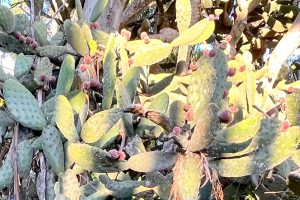
Living in San Diego since the ‘80s and being a member of a local walking group called Walkabout, International has made me very familiar with the Mission Hills neighborhood. But as time has passed, storefronts have changed, restaurants closed down, with others coming in to take their place. The neighborhood itself has retained the same quiet, almost mystical appearance with grand mansions and winsome cottages— all with gorgeous gardens.

Walkabout, International used to meet at Espresso Mio at the corner of Fort Stockton and Allen Rpad for Friday night strolls. But that little coffee shop overlooking a canyon is no longer there. In its place now is a sophisticated but warm and friendly dining experience called Wolf in the Woods.
Over the years, I had forgotten about that beautiful canyon behind the neighborhood, believing that it was not accessible anyway. But when I recently looked at a map of the area, thanks to information from San Diego Canyonlands, I was intrigued to learn about the very small Allen Canyon that starts right at the top of a very long driveway on the corner of Fort Stockton and Allen Road. Formerly called Allen’s Dairy Road, the canyon runs from Fort Stockton Avenue all the way down to Mission Valley, a quarter mile east of the Presidio. However, poor trail maintenance means hikers cannot connect to Mission Valley.

The late afternoon when my husband and I explored the trail, dozens of hidden birds sang in the shaggy eucalyptus trees. A crow snooped around, probably looking for eggs and young of the songbirds.
Nasturtium plants love Allen Canyon. The giant leaves of this cheerful orange and yellow flower hug the sides of the road as you walk down. Prickly pear cactus, probably a hundred years old, have some showy flowers atop the fruit called tuna, a red radish-shaped fruit that can actually be eaten along with the fleshy green part of the cactus known as Nopales, often served raw or in dishes such as omelets in the Southwest.
As we ambled down the road, we were surprised by the depth of the canyon, over which rambling houses peer. It’s a secret place, somewhere you’d never expect to find with a path open to the public beckoning you to go any further.
But there the sign was, off to the left just past the trail entrance when we came to the end of the paved road: Allen Canyon Nature Trail.

We looked up and around us, bending low under the trees, stopping to examine healthy, old lemonade berry and laurel sumac shrubs. Intertwined among them was wild cucumber vine, with its curly tendrils, small white flowers, and large prickly cucumber fruit.
The trail got narrower and more difficult to navigate as we walked further down. Medium and large creek cobblestones made it impossible for us to walk any further. It’s a good idea to wear very sturdy hiking boots for this trail.

But even if you get no further than we did, the experience of walking the steep Allen road down to the beginning part of the nature trail will give you a fresh new vision. As we trudged our way back up the steep road, we had worked up an appetite and considered Wolf in the Woods for dinner, but decided to make a reservation for another evening when we were a bit better dressed for this elegant enclave.
The history of Allen Road is a storied one, which writer Margot Sheehan wrote about for The Reader in 1992. She explained that in 1885, Mr. and Mrs. Sereno Allen arrived here from Kansas, went into the milk business, and raised 13 children. Their dairy prospered under sons Fred and Harvey.

In the meantime, this old milk-truck route was labeled on maps as Canyon Road, even though the Mission Hills residents always named it Allen’s Dairy Road. Later, when another Allen Street in San Diego was washed out, the city officially designated the truck road as Allen Road, making plans to grade and pave it.
But for 20 years, the people of Mission Hills dug in their heels and blocked the proposed improvement. Finally, in the 1960s the city gave up.
And so the gift of Mission Hills residents to the community is a gorgeous little canyon filled with trees and shrubs bristling with birds; a creek with large cobblestones; perhaps an artifact or two left from the dairy days of Mission Valley; and very possibly, a wolf in the woods.









